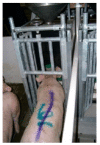The Feeding Behaviour Habits of Growing-Finishing Pigs and Its Effects on Growth Performance and Carcass Quality: A Review
- PMID: 35565555
- PMCID: PMC9099574
- DOI: 10.3390/ani12091128
The Feeding Behaviour Habits of Growing-Finishing Pigs and Its Effects on Growth Performance and Carcass Quality: A Review
Abstract
Based on the available data of feeding behaviour habits (FBHs), this work aimed to discuss which type of pig, according to its FBHs, performs better and is more efficient. As pigs grow, average daily feed intake, meal size, and feeding rate increase, whereas small variations or even decreases in time spent eating and daily feeder visits have been reported. Moreover, the sex, breed, space allowance, feeder design, feed form, diet composition, and environmental conditions modify FBHs. On the other hand, the literature indicates the existence of four types of pigs: pigs that eat their daily feed intake in many short meals (nibblers) or in few large meals (meal eaters) combined with eating fast (faster eaters) or slow (slow eaters). The available scientific literature about ad libitum fed pigs suggests that pigs eating faster with bigger meals eat more, gain more weight, and are fatter than pigs eating less, slower, and with smaller meals. However, the feeding rate and the meal size do not influence feed efficiency. In conclusion, studies comparing growing-finishing pigs with similar feed intake, but different feeding rate and meal size are needed to better understand the influence of FBHs on feed efficiency.
Keywords: carcass; feeding behaviour; growing-finishing pig; growth performance.
Conflict of interest statement
The authors declare no conflict of interest.
Figures






Similar articles
-
Meta-analysis on the effects of the physical environment, animal traits, feeder and feed characteristics on the feeding behaviour and performance of growing-finishing pigs.Animal. 2012 Aug;6(8):1275-89. doi: 10.1017/S1751731112000328. Animal. 2012. PMID: 23217231
-
Feeding behavior of growing-finishing pigs reared under precision feeding strategies.J Anim Sci. 2016 Jul;94(7):3042-50. doi: 10.2527/jas.2016-0392. J Anim Sci. 2016. PMID: 27482691 Clinical Trial.
-
Effect of group size and feeder type on growth performance and feeding patterns in finishing pigs.J Anim Sci. 2002 Mar;80(3):568-74. doi: 10.2527/2002.803568x. J Anim Sci. 2002. PMID: 11890394
-
Effects of alginate and resistant starch on feeding patterns, behaviour and performance in ad libitum-fed growing pigs.Animal. 2014 Dec;8(12):1917-27. doi: 10.1017/S1751731114001840. Epub 2014 Aug 26. Animal. 2014. PMID: 25154351 Clinical Trial.
-
Feeding Behaviour in Group-Housed Growing-Finishing Pigs and Its Relationship with Growth and Feed Efficiency.Vet Sci. 2025 Feb 13;12(2):168. doi: 10.3390/vetsci12020168. Vet Sci. 2025. PMID: 40005928 Free PMC article.
Cited by
-
Effect of Sex on Intestinal Microbial Metabolites of Hainan Special Wild Boars.Animals (Basel). 2024 Jul 25;14(15):2164. doi: 10.3390/ani14152164. Animals (Basel). 2024. PMID: 39123691 Free PMC article.
-
Multi-Criteria Evaluation Model of Management for Weaned Piglets and Its Relations with Farm Performance and Veterinary Medicine Consumption.Animals (Basel). 2023 Nov 14;13(22):3508. doi: 10.3390/ani13223508. Animals (Basel). 2023. PMID: 38003126 Free PMC article.
-
Identification of factors affecting fattening efficiency of commercial pig herds and analysis of their impact at different performance levels.Sci Rep. 2024 Aug 29;14(1):20105. doi: 10.1038/s41598-024-70900-x. Sci Rep. 2024. PMID: 39209973 Free PMC article.
-
Alleviating Heat Stress in Fattening Pigs: Low-Intensity Showers in Critical Hours Alter Body External Temperature, Feeding Pattern, Carcass Composition, and Meat Quality Characteristics.Animals (Basel). 2024 Jun 1;14(11):1661. doi: 10.3390/ani14111661. Animals (Basel). 2024. PMID: 38891708 Free PMC article.
-
Genetic Characterisation of Feeding Patterns in Lactating Holstein Cows and Their Association With Feed Efficiency Traits.J Anim Breed Genet. 2025 Jul;142(4):373-380. doi: 10.1111/jbg.12911. Epub 2024 Nov 11. J Anim Breed Genet. 2025. PMID: 39526828 Free PMC article.
References
-
- InterPIG 2020 Pig Cost of Production in Selected Countries. 2020. [(accessed on 29 January 2022)]. Available online: https://afly.co/zhc6.
-
- Jia M.L., Zhang H., Xu J., Su Y., Zhu W.Y. Feeding frequency affects the growth performance, nutrient digestion and absorption of growing pigs with the same daily feed intake. Livest. Sci. 2021;250:9. doi: 10.1016/j.livsci.2021.104558. - DOI
Publication types
LinkOut - more resources
Full Text Sources
Research Materials

